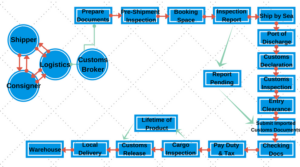If you’re already manufacturing a product, you understand how important tooling is. But what happens if your factory isn’t quite working out and you want to head to greener pastures? Or you’re ready to move production overseas? Do you have to start from scratch or can you take your tooling and molds with you? To answer that, we’ll start from the beginning.
So what exactly is tooling? Tooling is an essential part of the manufacturing process. Simply put, it is the designing, engineering, and creation of the tools that are needed to manufacture your product. This can include any needed molds as well. The quality, precision, and characteristics of tooling all determine how the finished piece will turn out as well as the speed, accuracy, and repeatability of manufacture.
Tooling and your product go hand in hand. Without tooling, it essentially wouldn’t be possible to make a consistent product at volume, which is why it makes sense to take your tooling with you—and in many cases it is certainly an option.
Tooling or mold transfers, especially large ones, do however require a lot of upfront planning and communication in order to meet the expectations of the project. It is an important initial part of the supply chain, which can influence the performance of timeline control and the success of the whole project. The transfer process involves multiple service providers such as the customer, freight forwarder, China customs, a customs clearance agency, warehousing, local shipping, and factories. If that sounds daunting to you, E-BI staff are fully prepared to handle these details if the situation arises, so your tools are received in a safe and timely manner.
Why might tooling be moved from one factory to another?
There are many reasons why production might be transferred from one location to another. Generally speaking, the decision to move tooling or molds could be to gain better quality, pricing, agreement terms, or service than the current factory is offering. However, it could also be due to a factory refusing to make your product or part any longer.
You might wonder why a factory would refuse to continue production–don’t they want business? That’s exactly it— a factory is a business and their decisions will likely rely on what is best for them. Sometimes the focus of the factory’s business changes and an item they had previously been producing no longer falls under the umbrella of their focus. Other times, a factory may gain a much larger production deal from another company and therefore their capacity, resources, and manpower are shifted to the grander project. There isn’t always enough to go around. Of course certain projects could also be causing a factory to lose money, often due to high overhead costs and low volumes. Or a factory might simply be going out of business, so all production stops.
Tooling Transfer Process Overview
All tooling transfers start with timely and effective communication. Accurate information needs to be collected before action is taken so all parties involved can plan and coordinate. This includes providing tooling details such as a description of the tools/molds to be transferred, their value, weight, size, design, quantity, used life span, packaging, and pictures. The ship date, consignee, destination, and other logistical information will then be confirmed.
For international transfers, there will of course be a much longer lead time for the process. It can take roughly 3 to 4 weeks to transport tooling from the U.S. to China, plus normally around 4 weeks to clear customs in China. This is why it is important to make sure you have enough product in inventory before the transfer in order to have a continuous supply.
Before arrival in China, a set of customs documents need to be prepared. The customs clearance process varies depending on the type of tools being transferred, the quantity, etc. There are strict regulation on what can be shipped when and where and there may be various stages of inspections depending on the item(s). A customs broker or customs clearing agent is useful at this stage.
The image below illustrates an example of what the import process may look like:
Once tooling is cleared through customs, it’s ready to be on its way for local delivery to the new factory. At arrival to the factory, generally the shipment will go through a checklist to make sure everything arrived as it should and in the condition that was expected. After set up and training, production gets underway in the new factory!
Challenges of Transferring Tooling
Depending upon the situation, tooling transfers can be a complex project. While physically moving tooling can be relatively simple, much of the challenge comes from the rules and regulations surrounding it.
When tooling is being made, a good contract is very helpful—later on the ownership of the tooling (you or the factory) can come into play and if it is not clearly defined, it can be a problem. Additionally, there is tax liability associated with your tooling. When it is transferred, there is a chance that it will be in a different tax zone, and thus there is a legal process to rezone it. For international transfers, your tooling will need to go through China Customs. Errors in  descriptions or documentation, even minor, can translate into significant delays. There also can be import issues with the residual value of the tools— tooling has a lifespan and the older the tool is, the harder it is to import.
descriptions or documentation, even minor, can translate into significant delays. There also can be import issues with the residual value of the tools— tooling has a lifespan and the older the tool is, the harder it is to import.
Upon arrival at the new factory there is a chance for issues as well. Because each factory is set up a bit differently, it isn’t known for certain if the tooling will work with the new set up until it arrives. Quality checks are performed to make sure the tooling is holding up to standards and to verify that no damage occurred during the physical transfer.
To learn more about transferring tooling, contact E-BI.


